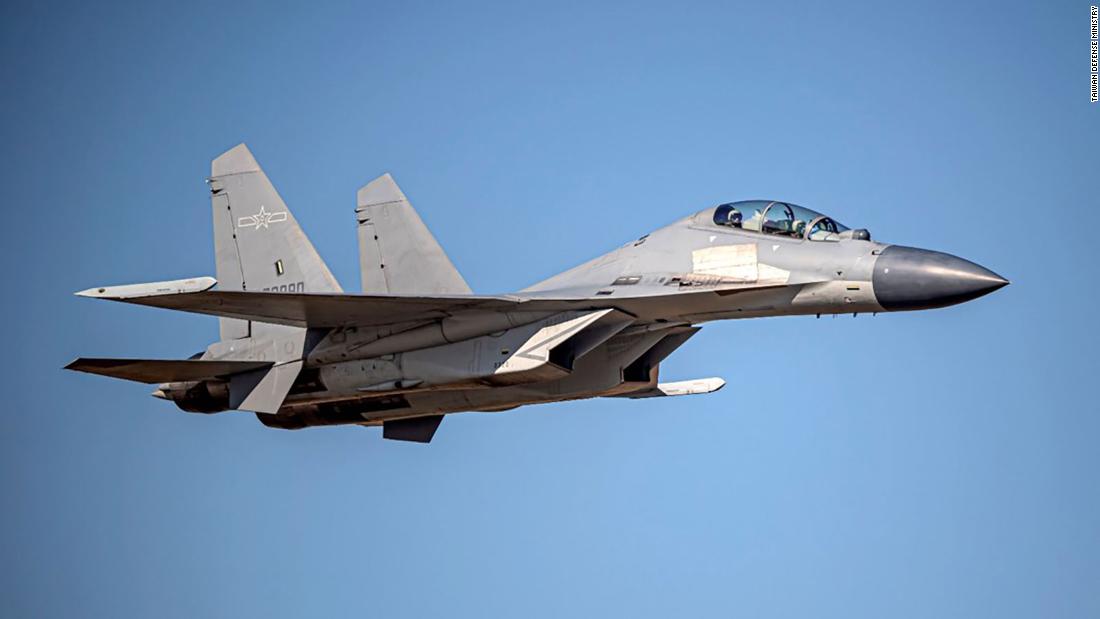
Chinese flights came a day after the US secretary of state warned Beijing that Washington was committed to defending the democratic and self-governing island, which China considers part of its sovereign territory.
The 25 aircraft deployed by the People’s Liberation Army of China (PLA) forces included 14 J-16 fighter jets, four J-10 fighter jets, four H-6K bombers, two anti-submarine warplanes and an airplane and early air control. to the Taiwan Ministry of Defense.
Taiwan responded by launching fighter jets, alerting missile defense systems and issuing radio warnings to Chinese aircraft that had entered the southwest corner of the island’s self-declared air defense identification zone (ADIZ), according to a ministry statement.
A graph provided by the ministry showed the flight routes of Chinese planes coming and going to mainland China, making 180-degree turns between the main island of Taiwan and Pratas Island in southeastern Hong Kong.
Taiwan began posting periodic updates on PLA flights near the island last September. By Monday, the largest number of Chinese warplanes entering Taiwan’s ADIZ was 20 jets turned on March 26th.
The U.S. Federal Aviation Administration defines an ADIZ as “a designated area of airspace over land or water within which a country requires the immediate and positive identification, location, and control of aircraft air traffic. in the interests of the national security of the country “.
Chinese planes have been making raids almost daily on Taiwan’s ADIZ in recent weeks as tensions heat up between Beijing and Taipei’s main supporter, the United States.
Beijing claims Taiwan as its territory, even though the democratic island of nearly 24 million people has been ruled separately for more than seven decades.
Chinese President Xi Jinping has vowed that Beijing will never allow Taiwan to formally become independent and has refused to rule out the use of force, if necessary, to unify the island with the mainland.
Analysts said the exercises were a warning to Taipei and Washington that Beijing would not address any movement for Taiwanese independence and was willing to act militarily to prevent this from happening.
U.S. Secretary of State Antony Blinken said Sunday that Washington remains committed to defending Taiwan.
“What really worries us is the increasingly aggressive actions of the Beijing government targeting Taiwan,” Blinken told NBC’s “Meet the Press.”
“We have a serious commitment to Taiwan being able to defend itself. We have a serious commitment to peace and security in the Western Pacific. And in this context, it would be a grave mistake for anyone to try to change this status quo by force,” Blinken said. .
Monday’s Chinese flights to Taiwan’s ADIZ continue with a pattern, said Bonnie Glaser, director of the China Power Project at the Center for Strategic and International Studies.
“Every time the United States takes a position on Taiwan that China doesn’t like or if Taiwan does something they don’t like, they usually break up activity in Taiwan’s air defense identification zone and, of course, sometimes around some of the islands that Taiwan occupies in the South China Sea, ”Glaser said.
China is rapidly accumulating weapons and systems to militarily overwhelm the island, leaders said.
“My view is that this issue is much closer to us than most believe,” warned Admiral John Aquilino, the admiral chosen to be the next commander of U.S. forces in the Pacific, at a hearing. before the Senate Armed Services Committee.
China considers establishing full control over Taiwan to be its “number one priority,” Aquilino added.
The current head of command, Admiral Philip Davidson, said at a hearing earlier this month that China could be ready to take Taiwan by force in the next six years.
CNN’s Angus Watson and CNN’s Beijing office contributed to this report.